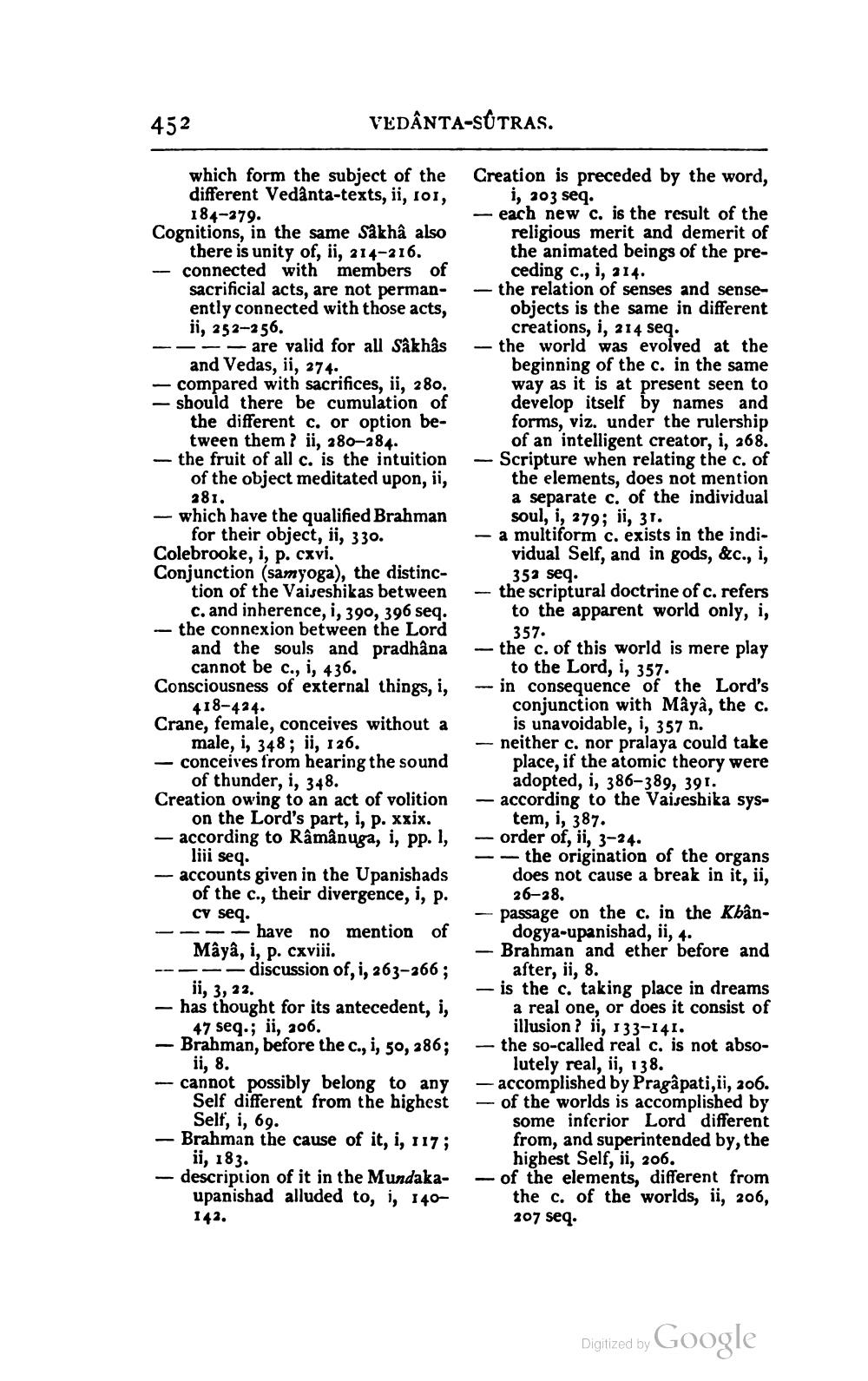________________
452
VEDANTA-SUTRAS.
which form the subject of the different Vedanta-texts, ii, 101, 184-279.
Cognitions, in the same Såkhâ also there is unity of, ii, 214-216. connected with members of sacrificial acts, are not permanently connected with those acts, ii, 252-256.
- are valid for all Sâkhâs and Vedas, ii, 274.
- compared with sacrifices, ii, 280. - should there be cumulation of the different c. or option between them? ii, 280-284. the fruit of all c. is the intuition of the object meditated upon, ii,
281.
- which have the qualified Brahman for their object, ii, 330. Colebrooke, i, p. cxvi. Conjunction (samyoga), the distinc
tion of the Vaiseshikas between c. and inherence, i, 390, 396 seq. the connexion between the Lord and the souls and pradhâna cannot be c., i, 436. Consciousness of external things, i,
418-424. Crane, female, conceives without a male, i, 348; ii, 126.
- conceives from hearing the sound of thunder, i, 348.
Creation owing to an act of volition on the Lord's part, i, p. xxix. - according to Râmânuga, i, pp. 1, liii seq.
- accounts given in the Upanishads of the c., their divergence, i, p. CV seq.
-
have no mention of Mâyâ, i, p. cxviii.
discussion of, i, 263-266;
ii, 3, 22.
- has thought for its antecedent, i, 47 seq.; ii, 206. -Brahman, before the c., i, 50, 286; ii, 8.
- cannot possibly belong to any Self different from the highest Self, i, 69.
-Brahman the cause of it, i, 117;
ii, 183. description of it in the Mundakaupanishad alluded to, i, 140
142.
Creation is preceded by the word, i, 203 seq.
- each new c. is the result of the religious merit and demerit of the animated beings of the preceding c., i, 214.
-the relation of senses and senseobjects is the same in different creations, i, 214 seq.
- the world was evolved at the beginning of the c. in the same way as it is at present seen to develop itself by names and forms, viz. under the rulership of an intelligent creator, i, 268. Scripture when relating the c. of the elements, does not mention a separate c. of the individual soul, i, 279; ii, 31.
- a multiform c. exists in the individual Self, and in gods, &c., i, 352 seq.
the scriptural doctrine of c. refers to the apparent world only, i, 357.
-the c. of this world is mere play to the Lord, i, 357.
-in consequence of the Lord's conjunction with Mâyâ, the c. is unavoidable, i, 357 n.
- neither c. nor pralaya could take place, if the atomic theory were adopted, i, 386-389, 391. according to the Vaiseshika system, i, 387. order of, ii, 3-24.
-
the origination of the organs does not cause a break in it, ii, 26-28.
-passage on the c. in the Khândogya-upanishad, ii, 4. -Brahman and ether before and after, ii, 8.
- is the c. taking place in dreams a real one, or does it consist of illusion? ii, 133-141.
1
the so-called real c. is not absolutely real, ii, 138. accomplished by Pragâpati,ii, 206. of the worlds is accomplished by some inferior Lord different from, and superintended by, the highest Self, ii, 206.
- of the elements, different from the c. of the worlds, ii, 206, 207 seq.
Digitized by Google




